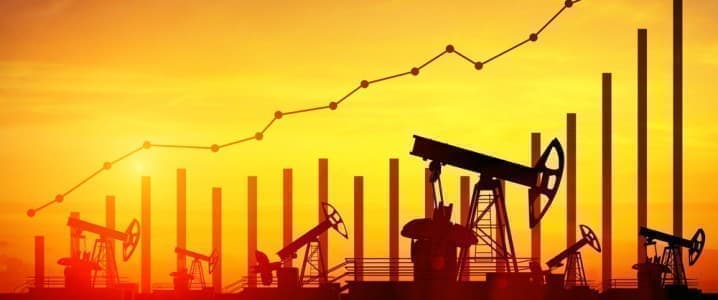U.S. shale producers are tempted to boost production more than previously expected as oil prices rallied to over $90 a barrel with a potential to hit $100 soon. Yet, a supply chain bottleneck for a key material for fracking could slow the coming shale boom.
Frac sand in the biggest shale play, the Permian, is in short supply, threatening to slow drilling programs at some producers and sending sand prices skyrocketing. This adds further cost pressure to American oil producers, who are already grappling with cost inflation in equipment and labor shortages.
Total U.S. crude oil production is set to rise to an average of 12.0 million barrels per day (bpd) in 2022 and 12.6 million bpd in 2023—an annual record high and 200,000 bpd above last month's estimate, the EIA said in its February Short-Term Energy Outlook (STEO) last week. The previous annual average record of 12.3 million bpd was set in the pre-pandemic 2019.
Crude oil production in the seven most prolific U.S. shale basins is set to increase to 8.707 million bpd in March—a 109,000 bpd rise over February's 8.598 million bpd, and an increase of 271,000 bpd from January's tally, the EIA's latest Drilling Productivity Report showed.
However, cost pressures and sand shortages could slow the growth going forward.
"Ultimately it will slow everyone down if it doesn't resolve itself," Michael Oestmann, CEO of private equity-backed Tall City Exploration, told Reuters, commenting on the sand supply crunch in the Permian.
Not enough frac sand at a time when oil prices topped $90 a barrel could limit the growth as more and more shale firms – especially privately-held ones – seek to boost production materially to capture the high oil prices.
$100 oil could unleash a lot more U.S. oil production, in theory, but supply chain constraints and record-high sand prices are likely to temper growth, analysts say.
"Although high prices would, in theory, trigger a burst in tight oil production, acute supply chain bottlenecks, a lag between price signals and its impact on production, and winter weather-related disruptions will slow growth. Added to this are expectations that spot sand prices will rise to a $50-$70 per ton range – a level unheard of in the industry's modern history – which will hit operators' wallets," Artem Abramov, Rystad Energy's head of shale research, said earlier this week.
Sand tightness, cost pressures, and labor shortages could be deterrents to a massive outburst in U.S. shale production, even if most public companies were to abandon restraint and risk angering Wall Street by seeking to significantly raise output.
Oilfield services firms, while hailing the coming of a "multi-year upcycle" in shale, are warning against sand tightness and labor and cost pressures.
"There is no doubt, the much-anticipated multiyear upcycle is now underway," Jeff Miller, CEO at the biggest fracking services provider, Halliburton, said on the Q4 earnings call last month. But he also noted that "As activity accelerates, the market is seeing tightness related to trucking, labor, sand, and other inputs."
During the fourth quarter, Halliburton saw the North American market moderate growth slightly in completions due to the holidays, sand supply tightness, and lower-efficiency levels typically experienced in the winter months, Miller said.
ADVERTISEMENT
Liberty Oilfield Services, which bought last-mile frac sand logistics firm PropX during the COVID-inflicted downturn, also flagged "recent sand bottleneck challenges in the Permian Basin, both of sand availability and last mile transportation," as chief executive Chris Wright said last week.
If sand and trucking shortages are not resolved soon, U.S shale producers – especially privately-held drillers who are already increasing production – may not benefit from $90 and $100 oil as much as they have thought.
By Tsvetana Paraskova for Oilprice.com
More Top Reads From Oilprice.com:
- Chinese EV Stocks Are Flying Again
- Oil Refining Industry Can't Keep Up With Demand
- Even OPEC Thinks Oil Prices Are Too High



















The real reason is the all the sweet spots in the shale plays have been utilized and drillers are now moving to poorer and less productive spots. Another reason is that well productivity has been declining. Yet a third reason could be capital expenditure discipline.
The truth of the matter is that failure of shale drillers to raise production significantly has less to do with capital discipline and more to do with inability to do so.
And yet, Fatih Birol the chief of the IEA has been calling on OPEC+ then pleading with it and soon he will be begging it to raise production but never once called on shale drillers to raise their production. The reason could be that either he, as the hype leader of shale oil, has been deluding himself about the potential of shale oil or he knowingly didn’t want to expose to the world the inability of shale oil drillers to raise production.
Then there is Rystad Energy, another major hype leader who claims that at $100 a barrel, shale oil production could rise by 2.2 million barrels a day (mbd) by 2023. If that is true, they could have done it when Brent crude hit $70 being higher than the breakeven price of shale oil at $45-$68 a barrel.
The maximum shale oil production could rise is estimated at 200,000-300,000 barrels a day (b/d) in 2022.
Dr Mamdouh G Salameh
International Oil Economist
Visiting Professor of Energy Economics at ESCP Europe Business School, London